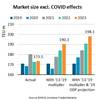Containership Alliance P3 Abandoned: Implications Analysed
So, Maersk, MSC and CMA CGM will not be allowed to form what would have been the largest mega-alliance in the shipping industry. But what are the implications, and what is likely to happen next? Drewry Martime Research consider these questions in their latest Container Insight Weekly.
China’s regulators have blocked the P3 mega-alliance between Maersk, MSC and CMA CGM on the grounds that it infringes the country’s competition laws between Asia and Europe, particularly with respect to the lines’ combined market share of 46.7%. The law enforcers appear to believe that the cost reductions gained by the P3 carriers would either have been offset by this unacceptably high risk of market concentration, or would not have been passed back to shippers satisfactorily.
The unexpected decision effectively inhibits the carriers’ ability to reduce costs by pooling assets and controlling over-capacity, but the news will be good for their competitors and ports, despite not stopping the three from working together in other areas.
Whatever they decide to do next, Maersk, MSC and CMA CGM will not be able to save the hundreds of millions of dollars a year envisaged through P3’s greater economies of scale, which explains why Maersk’s shares plummeted 8% just after China’s announcement, wiping $3.5bn off the company’s market value in a day.
Maersk and CMA CGM were certainly building in substantial cost savings over the next few years from a successful P3 launch. They had clearly indicated this to the financial community without putting a number on it, prompting analysts to build in billions of dollars of savings in their future forecasts. The three carriers will, consequently, be encouraged to go back to the drawing board and revisit their cost optimisation models, which will be a challenging task.
Although P3 would have been financially beneficial to its members, its withdrawal is not a complete disaster for them, so the market is probably overreacting. Maersk and CMA CGM are already industry unit cost and profit leaders without P3, and will continue to outperform others in this respect. MSC’s financial results are not published, so it is not possible to say if they are in the same position, but it is probably similar.
For carrier competitors, including the Chinese lines, the cancellation of P3 by China’s regulators removes the threat of a very powerful mega-alliance. But one still has to fear that the overall carrier industry will struggle to control capacity as well as it might have done had P3 been approved. For example, without P3, Maersk, MSC and CMA CGM will not be able to reduce their weekly Asia-North Europe services from 9 (deploying a fleet of 107 vessels averaging 11,950 teu) to 8, or their Asia/Mediterranean services from 6 (deploying a fleet of 65 vessels averaging 10,670 teu) to 5.
For shippers, it means that Maersk, MSC and CMA CGM will continue to provide separate services, so retain the same product differentiation. The carrier industry will remain fragmented and the prospect of dealing with just a few carriers (one each from each of the 3 mega-alliances) will not happen for now.
For ports and terminals, P3 was seen as both a risk and an opportunity. A risk because it is claimed that the alliance would have been able to leverage its huge volume to dominate commercial negotiations with terminals, even though it assured US regulators that terminal contracts would not be negotiated jointly. An opportunity, because new business could be won by those with the necessary resources.
So what happens now?
Firstly, as mentioned earlier, Maersk, MSC and CMA CGM will have to find new ways to reduce their operating costs.
Secondly, Maersk, MSC and CMA CGM will be allowed to continue their numerous existing bi-lateral and tri-lateral vessel-sharing agreements and slot-exchange agreements on the transpacific and Asia-Europe routes (as shown in the table, which exludes the Asia-Mexico services – AC1, AC2 and PEX2).
They might even be allowed to form a tri-lateral consortium in the Transpacific, as their current 20% market share of effective eastbound vessel capacity to the West Coast alone is well below the G6’s 34%. This would enable them to deploy surplus ULCVs from the Asia/Europe trade lane on the route, and cascade the displaced vessels into other services, which may well have been envisaged at the outset of P3.
Thirdly, because the US Federal Maritime Commission and the European Commission have not blocked the alliance, the three carriers could decide to implement joint services on the transatlantic route, as planned, even without a P3 global setup. As the Atlantic is such a low-volume route, merged operations in this trade would provide little consolation to the three carriers, however.
Fourthly, as filling the new 18,000 teu ships without the ability to pool assets and volumes will be much harder, other solutions will have to be found, including the greater use of pendulum services. Without this, the lines will find it difficult to achieve high utilisation rates, thus under-achieving the vessels’ economies of scale. This will be particularly challenging to Maersk between Asia and Northern Europe, and to MSC between Asia and the Mediterranean, due to their lack of partners.
In summary, Chinese regulators may have stopped the world’s three largest carriers from joining forces between Asia and Europe, but many other cost cutting measures are still available to them, even though their efficiency gains will be less.
Drewry's View
The cancellation of P3 will probably postpone the stabilisation of the over-supplied and unprofitable carrier industry, but the further development of mega-alliances will not stop here.
Source: Drewry Maritime Research











